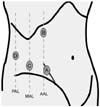Abstract
Purpose
To evaluate the results of our experience with a retroperitoneoscopic nephroureterectomy, in patients with transitional cell carcinomas of the renal pelvis and ureter, compared to those treated by open nephroureterectomy.
Materials and Methods
Between August 2003 and February 2006, 17 patients with a transitional cell carcinoma of the upper urinary tract underwent retroperitoneoscopic nephroureterectomy. The distal ureter and bladder cuff was treated with a Gibson incision in 11 patients, with an endoscopic stapler employed in 6 patients. During the endoscopic stapler firing of the bladder cuff, complete removal of the ureteral orifice was confirmed using a flexible cystoscope. The patients' operative and clinical records were retrospectively reviewed, and compared to 16 patients with a transitional cell carcinoma of the upper urinary tract treated using an open nephroureterectomy.
Results
The retroperitoneoscopic nephroureterectomies were successfully performed in all patients. The mean operative time, transfusion rate and time to drain removal were not significantly different between the two groups. The initiations of the postoperative oral intake and ambulation, as well as the hospital stay were shorter in the retroperitoneoscopy than the open group. Complications were detected in 1 and 5 patients of the retroperitoneoscopy and open groups, respectively. With respect to the follow-up results, no statistical differences were seen in either bladder or extravesical recurrence between the two groups.
Conclusions
A retroperitoneoscopic nephroureterectomy is a less invasive technique than an open nephroureterectomy for patients with a transitional cell carcinoma of the renal pelvis and ureter. Especially, using an endoscopic stapler for the lower ureter and bladder cuff may shorten the operative time. However, long term follow-up will be necessary to confirm the cancer control effects.
Figures and Tables
 | Fig. 1Trocar sites and incision location for right-sided procedure. A 12mm blunt tip trocar (A) is placed in the original incision, a second 5/12mm trocar (B) is placed just below the costal margin in the anterior axillary line (AAL), a third 5/11mm trocar (C) is placed 1cm below the umbilicus in the mid-axillary line (MAL), fourth 5mm trocar (D) is placed on the level of umbilicus in the posterior axillary line (PAL). |
 | Fig. 2Laparoscopic finding of the clamped lower ureter and bladder cuff using endoscopic stapler, and cystoscopic finding of the pulled ureteral orifice (arrow). |
Table 2
Operative data and complications: number of patients (%) and mean values (standard deviation)

References
1. Dunn MD, Portis AJ, Shalhav AL, Elbahnasy AM, Heidorn C, McDougall EM, et al. Laparoscopic versus open radical nephrectomy: a 9-year experience. J Urol. 2000. 164:1153–1159.
2. McDougall EM, Clayman RV, Elashry O. Laparoscopic nephroureterectomy for upper tract transitional cell carcinoma: the Washington University experience. J Urol. 1995. 154:975–980.
3. Gill IS, Sung GT, Hobart MG, Savage SJ, Meraney AM, Schweizer DK, et al. Laparoscopic radical nephroureterectomy for upper tract transitional cell carcinoma: the Cleveland Clinic experience. J Urol. 2000. 164:1513–1522.
4. Shalhav AL, Dunn MD, Portis AJ, Elbahnasy AM, McDougall EM, Clayman RV. Laparoscopic nephroureterectomy for upper tract transitional cell cancer: the Washington University experience. J Urol. 2000. 163:1100–1104.
5. Jeong YR, Park HY, Lee TY. The early experience of retroperitoneoscopic nephroureterectomy for upper urinary tract transitional cell carcinomas. Korean J Urol. 2003. 44:28–33.
6. Kim DW, Rye DS, Oh TH. Initial experience of retroperitoneal laparoscopic nephroureterectomy for upper urinary tract transitional cell carcinoma. Korean J Urol. 2005. 46:382–387.
7. Gaur DD. Laparoscopic operative retroperitoneoscopy: use of a new device. J Urol. 1992. 148:1137–1139.
8. Ono Y, Katoh N, Kinukawa T, Matsuura O, Oshima S. Laparoscopic nephrectomy via the retroperitoneal approach. J Urol. 1996. 156:1101–1104.
9. Gill IS. Retroperitoneal laparoscopic nephrectomy. Urol Clin North Am. 1998. 25:343–360.
10. Gill IS, Rassweiler JJ. Retroperitoneoscopic renal surgery: our approach. Urology. 1999. 54:734–738.
11. Salomon L, Hoznek A, Cicco A, Gasman D, Chopin DK, Abbou CC. Retroperitoneoscopic nephroureterectomy for renal pelvic tumors with a single incision. J Urol. 1999. 161:541–544.
12. Keeley FX Jr, Tolley DA. Laparoscopic nephroureterectomy: making management of upper-tract transitional cell carcinoma entirely minimally invasive. J Endourol. 1998. 12:139–141.
13. Gill IS, Soble JJ, Miller SD, Sung GT. A novel technique for management of the en bloc bladder cuff and distal ureter during laparoscopic nephroureterectomy. J Urol. 1999. 161:430–434.
14. Yoshino Y, Ono Y, Hattori R, Gotoh M, Kamihira O, Ohshima S. Retroperitoneoscopic nephroureterectomy for transitional cell carcinoma of the renal pelvis and ureter: Nagoya experience. Urology. 2003. 61:533–538.
15. Hetherington JW, Ewing R, Philip NH. Modified nephroureterectomy: a risk of tumor implantation. Br J Urol. 1986. 58:368–370.
16. Jones DR, Moisey CU. A cautionary tale of the modified pluck nephroureterectomy. Br J Urol. 1993. 71:486.
17. Arango O, Bielsa O, Carles J, Gelabert-Mas A. Massive tumor implantation in the endoscopic resected area in modified nephroureterectomy. J Urol. 1997. 157:1839.
18. Steinberg JR, Matin SF. Laparoscopic radical nephroureterectomy: dilemma of the distal ureter. Curr Opin Urol. 2004. 14:61–65.
19. Hattori R, Yoshino Y, Gotoh M, Katoh M, Kamihira O, Ono Y. Laparoscopic nephroureterectomy for transitional cell carcinoma of renal pelvis and ureter: Nagoya experience. Urology. 2006. 67:701–705.
20. El Fettouh HA, Rassweiler JJ, Schulze M, Salomon L, Allan J, Ramakumar S, et al. Laparoscopic radical nephroureterectomy: results of an international multicenter study. Eur Urol. 2002. 42:447–452.
21. Bariol SV, Stewart GD, McNeill SA, Tolley DA. Oncological control following laparoscopic nephroureterectomy: 7-year outcome. J Urol. 2004. 172:1805–1808.




 PDF
PDF ePub
ePub Citation
Citation Print
Print





 XML Download
XML Download